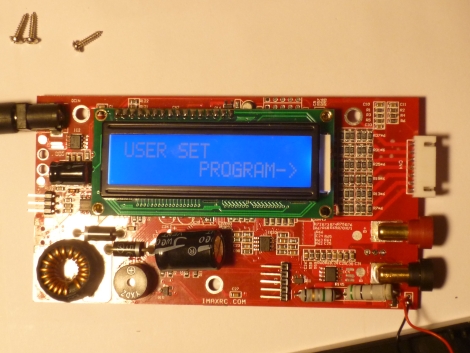
[Dane] bought a reasonably cheap ($17) Hobbyking Echo-6 battery charger and wanted to see what sort of information he could pull from the unit. Since the charger is designed for a variety of battery chemistries and sports an LCD screen, he figured that it contained a fairly decent microcontroller which he could tap into for some useful data.
He disassembled the unit and started looking around for any useful items. He discovered that it used an ATMega32 microcontroller and had quite a few unpopulated areas on the PCB, which led [Dane] to believe that the Echo-6 shared its main board with a more robust charger. He tapped into the ATMega’s UART and began seeing data immediately. Once he figured out what was coming over the serial line, he piped the data into LogView, resulting in some nice graphs showing off the charge/discharge processes in detail.
Tapping into the Echo-6 seems easy enough for any skill level, and we assume that just about anyone would benefit from getting kind of information out of their battery charger.















Can’t say how well it works in practice, but that looks like a really nice tool for $17.
Though I’m curious what those rows of bussed SMT components (resistors?) are for on the lines leading to the JST connector.
“Though I’m curious what those rows of bussed SMT components (resistors?) are for on the lines leading to the JST connector.”
Probably to increase the amount of power they could handle and to keep down the cost of hand placed parts. But neither make a whole lot of sense as near the bottom of the same right end side of the board are large through hold resistors.
If they are resistors it seems like it would be a waste of expenses to create.
They are probably for the balancing function of the charger, balancing each array
I’ve reversed the firmware because I received one from a clone maker and they didn’t bother to set the code protection fuses. Check out the discussion here: http://www.rcgroups.com/forums/showthread.php?t=827821 – there’s lots of good hacking info including how to upgrade the resistors so the balancer doesn’t damage individual LiPo cells.
And I’m working on GPL firmware here: http://www.rcgroups.com/forums/showthread.php?t=1370248
I go to order one of these awesome things, out of stock. Did they have like 2 or did HaD readers raid the site?
Why not just buy the complete USB Kit with monitoring software for 10 euro ?
http://www.ev-peak.com/en/productview.asp?id=25
or
http://www.osmot.net/osmot-macropower-datalogging-fuer-osmot-mserie-p-6369-3.html
This kit plugs into the temp out slot of the charger (have to enable USB in chargermenue first)
Not all these type of chargers have the serial out. Some designs use the pins for a temp sensor.
@Robert: where’s the fun in that ? ;)